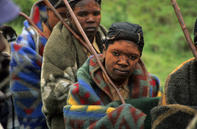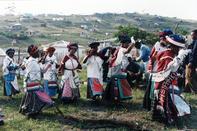Ntsikana Prophecies
The Xhosa on the Eastern Cape frontier were the first Cape Nguni chiefdom who were exposed to European explorers, hunters, traders, missionaries, soldiers and colonial administrators on an ever-increasing scale from the late 18th century onwards.

These cross-cultural contacts were to have profound effects on Cape Nguni culture which, to some extent, are still discernible to this day. Ntsikana, a famous Xhosa prophet who died in 1821, was a convert of the Reverend Joseph Williams of the London Missionary Society. Although he was an illiterate man, Ntsikana composed hymns, which are still sung by modern-day Christian congregations.
In addition, he made fascinating prophecies, warning of the growing importance of 'buttons without holes' - money, and foretelling of 'snakes belching fire' - trains, which would move over the countryside.
Conversion to Christianity resulted in the development of a major cleavage in Cape Nguni society, which was to last up until the 1950s, between the so-called 'School' people and 'Red' traditionalists. The former, who embraced Christianity and Western education, were essentially the product of the mission stations and schools.
Cape Nguni Culture

The Cape Nguni people were greatly influenced by contemporary Europe, particularly English-speaking culture, as imparted to them in word and deed by the European missionaries. The 'School' people adopted a distinctive style of dress and evolved cultural traditions which centred on church and school.
Traditionalists were described as 'Red' because of their practice of smearing red clay on their faces and bodies. Rejecting both the church and Western education as foreign introductions, the traditionalists continued to perform time-honoured rituals centring around the spirits of the ancestors. Xhosa-speakers are today predominantly Christian.
Even chiefs and traditional healers - diviners and herbalists - are nominal if not practising Christians. Nevertheless, the Christianity of the Xhosa is increasingly one which has reached various forms of accommodation with the ancestors and the traditional rituals commemorating them.
Ironically, the ornaments which came to symbolize traditional dress par excellence, particularly in the 20th century, are the product of an indigenous, principally female craft that developed around an introduced item of trade from Europe: the coloured glass bead, which became freely available in the mid-19th century.